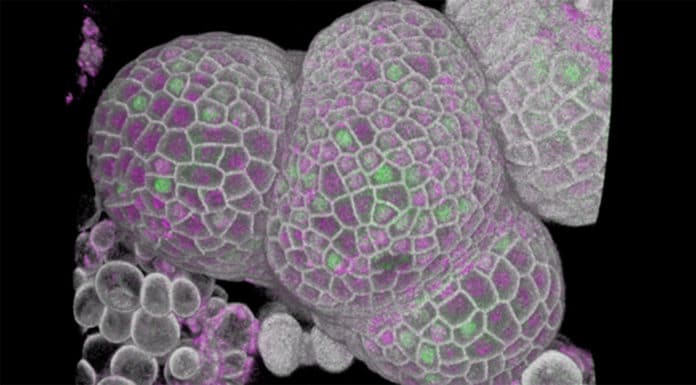Since the discovery of cells, it is well known that the cells have their usual size. They come in different sizes, like tiny bacteria or inches-long neurons.
The functioning of the cells depends on their size. However, it remains obscure that how the cells regulate their size.
Scientists from the John Innes Centre now have explained the biological mechanism of the cell.
By mainly focusing on the growing tip of plants, scientists determined that cells use their DNA content as an internal gauge to assess and adjust their size.
Professor Robert Sablowski, a group leader at the John Innes Centre and corresponding author of the study, said: “It has been suggested for a long time that DNA could be used as a scale for cell size, but it was unclear how cells could read the scale and use the information. The key is to use the DNA as a template to accumulate the right amount of protein, which then needs to be diluted before the cell divides. It’s exciting to come across such a simple solution to a long-standing problem.”
“The average cell size results from a balance between how much cells grow and how often they split in two. It has long been clear that cells grow to a certain size before they divide.”
But how can a cell know how much it has grown?
To figure out the answer to this question, scientists focused on shoot meristem, the plant’s growing tip. Shoot meristem supplies new cells to make leaves, flowers, and stems. The cells constantly grow and divide.
However, this division is not even leading to different sizes of cells. Over time, these differences should build-up, but the meristem cells stay within a narrow range of sizes over long periods.
By examining the growth and division of meristem cells over time, scientists found that although cells can start their life with variable sizes, by the time the cells are ready to replicate their DNA, most of the initial variability in cell sizes has been corrected.
Scientists then studied the role of a protein called KRP4. The protein plays a vital role in delaying the start of DNA replication. Guess what, it was found that regardless of their initial size, cells were always born with the same amount of KRP4.
This signifies that when a cell is born too small, it receives a higher concentration of KRP4, which delays its progression to DNA replication, allowing time for the cell to catch up to the same size as the other cells. Conversely, if a cell is born too big, KRP4 is diluted to move quickly onto the next stage without growing further. Over time this keeps meristem cells within a narrow size range.
What ensures that cells start with the same amount of KRP4?
KRP4 “takes a ride” on the DNA during the division of cells, which is given in identical copies to each newborn cell.
Thusly, the underlying measure of KRP4 becomes proportional to the cell’s DNA content. To ensure that KRP4 aggregates in the mother cell with respect to the DNA content, any abundance of KRP4 not bound to the DNA is obliterated before cell division by another protein called FBL17.
Mathematical models and using gene-edited mutants with differing amounts of these genetic components affirmed the instrument.
Professor Robert Sablowski explains this process, “One riddle we had to solve is how a cell can know how much it has grown when most of the components of a cell increase together in number and size so they cannot be used as a fixed ruler to measure size. One exception is DNA which exists in the cell in a discrete amount — its amount precisely doubles before cell division, but it does not vary with cell growth.”
In future experiments, scientists will determine how the regulatory protein KRP4 associates, then dissociate from chromosomes during cell division.
Journal Reference:
- Marco D’Ario, Rafael Tavares, Katharina Schiessl, Bénédicte Desvoyes, Crisanto Gutierrez, Martin Howard, Robert Sablowski. Cell size controlled in plants using DNA content as an internal scale. Science, 2021; 372 (6547): 1176 DOI: 10.1126/science.abb4348
